The Legendary Maineiacs

Where Readers Have Found "Maineiacs" Stickers
The Air National Guard's 101st Aerial Refueling Wing, flying KC-135R Stratotankers out of Bangor ME are probably the most prolific of the zappers in the USAF, and have been for a long time. You can’t ride on a military bus or visit an airport USO without seeing one of their stickers aka zaps stuck somewhere. "Zapping" or "Tagging" is the action of placing a sticker from your unit onto another units aircraft or equipment. It often extends to anything that a sticker will adhere to, and the "Maineiacs" are legendary about getting them placed in locations that seem obscure, unexpected, or difficult to access. Read on to see Maintainer Humor's readers comments on where they have discovered them.
Note: Challenge Coin Nation carries stock stickers or can make custom stickers to your specifications. Contact us today for a free quote.
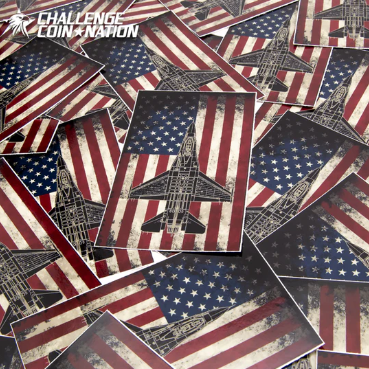
This Maineiacs sticker was spotted on a famous brand cruse ship.

Happy to see the #MAINEiacs coming up on this page. A great organization with a long and storied history in the tanker community. As a current member…I just so happen to have a handful of zaps in the glove box of my pickup for those special locations that might present themselves as needing a little love!
Best spot I’ve ever seen a Maineiacs Zap was IN a flightline urinal at a CENTCOM base….right where the stream hits…..
Rumor has it, there’s one on the Eiffel Tower. Every time the French removed it, another would appear within 24 hours. They finally gave up and left it. The Antonov had one at eye level when you stepped in the door.
You don't even have to be looking for them. I've seen them just about everywhere around the world that I've been...stateside or overseas. Pretty impressive.
I got one when they came to Guam for a TDY rotation.
Under the ejector pump floorboards on a 135 or in the left main gear well of an RAF Tornado. There is no place they can’t get to.
34 year MAINEiac here. Whenever I was TDY at an AF base anywhere, I used to take the clear cover off the wall clock and put a sticker on the face of the clock. Then cut the little airplane off another sticker and apply it to the second hand so that it flew around and around. The biggest one I applied was a 6 ft wide MAINEiac on the roof of the bar hooch at Incirlik AB, Turkey back in the Deny Flight Tent City days. I also stuck one dead center on a podium just moments before General Ron Fogleman spoke at a symposium. The CCTV showed him and the sticker on the big screen for everyone to see.
There was one printed in the 135-1 (Technical Order). On the page that showed where on the Electronic Rack the Autopilot Amp was located, the Amp had one stuck on it. I truly have no idea how that happened.
I once saw one high up on the vertical of a KC-135. (This is one on an airliner)
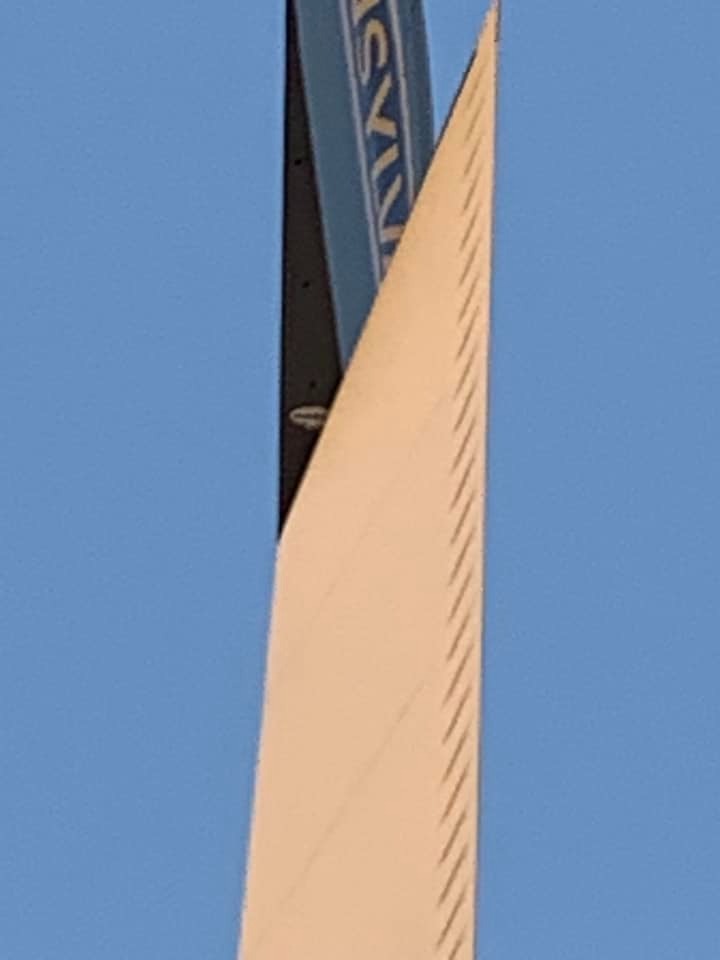
There was one on the door to the Subway/Green Bean at Bagram back in 2016.
The best zap was at the blue lagoon resort in Iceland about 20 feet up in the dome over the spa
Just saw one of there on a random bar door in Knoxville TN
So, was visiting the imperial war museum in Duxford England, saw the Concorde they have on display and sure enough there was a Maineiacs sticker on not only the steps leading onto the jet, but also on the inside.
I’m from Maine. Was surprised to see a maniacs sticker inside one of the planes I worked on in the Navy. They are everywhere lol
The list of “Where AREN’T there MAINEiacs stickers/zaps?” is probably shorter. I remember seeing them while on the road in the other service, before I joined the USAFR.
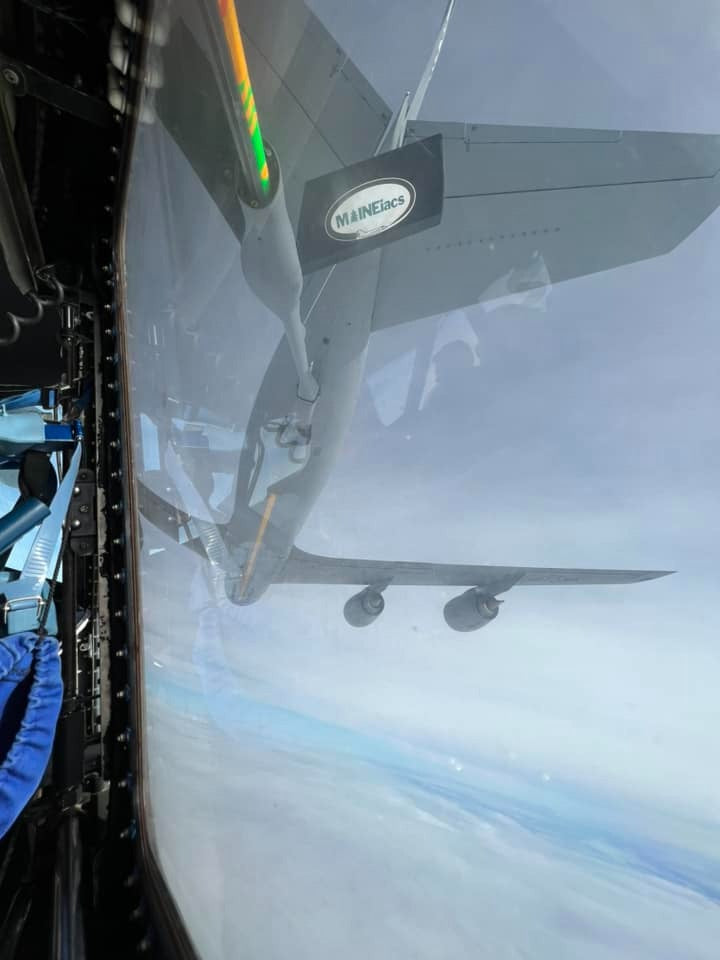
Alpena JRTC Michigan at the River Club.
I saw one on a pipe in the student dorms of the ART-CR course on Ft. Dix
As a kid in the 70s at every base we visited.
This is their game.. and they are winning!
Everywhere I've been, I've seen a Maineiacs sticker. Everywhere
I’ve seen them put a huge zap on a B-1. Like up by the cockpit. They also zapped my jet when it came through. In the speed brakes. QA wrote me up for that one.
Was very impressed to see one at the Vatican!
Under a pew at the Vatican.
Spotted one on the guard rail outside the gift shop on Hogback Mt. In Vermont.
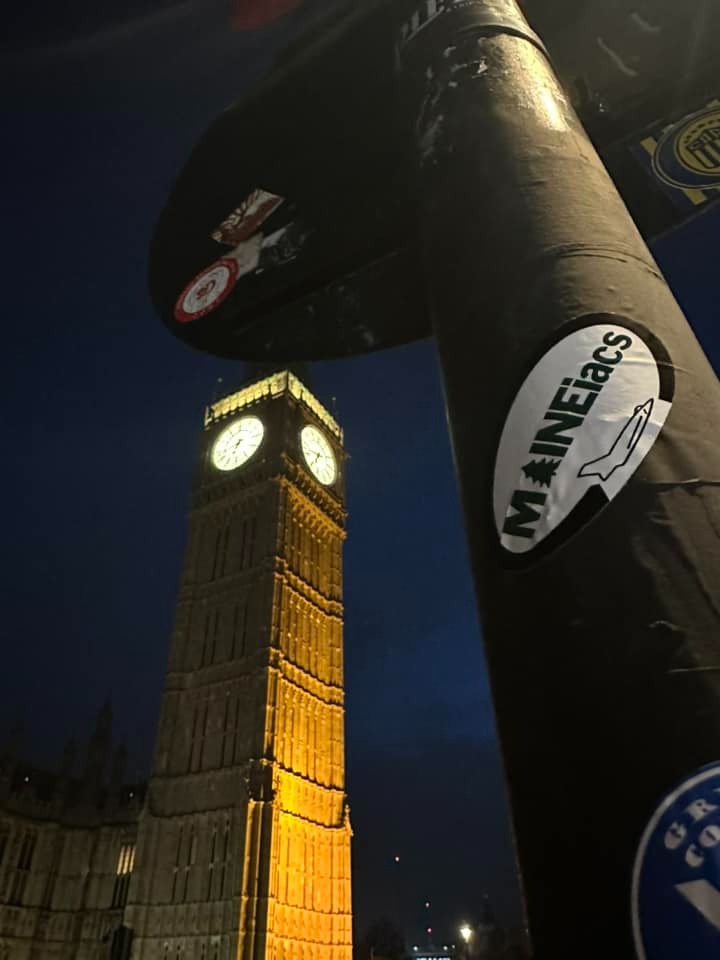
Everywhere in the tanker world and beyond. lol.
Funny thing is that they had a running contest with NH ANG and they would try and tag over each others zaps… NH even made their stickers the same shape, but just slightly larger so that it would cover the Maine zap completely… lol.
They're in submarines too...
Yep, every time they would go somewhere they would give each member a stack to go forth and tag it up!
I saw one halfway up the T-tail ladder inside the vertical stab of a C-5. Those guys are as crazy as the Aussies.
The amount of times I’ve come across one of those and say out loud “How did they get up there?”
I saw one in the O-club bar at RAF Alconbury in 2001. Also in the little choke and puke outside the front gate at mountain home AFB in 1994. Oh—and at RAF Duxford on the side of the Concorde in the museum.
We always said you know your deployment was too long when you come home and find a Maineiac sticker on your bed frame.
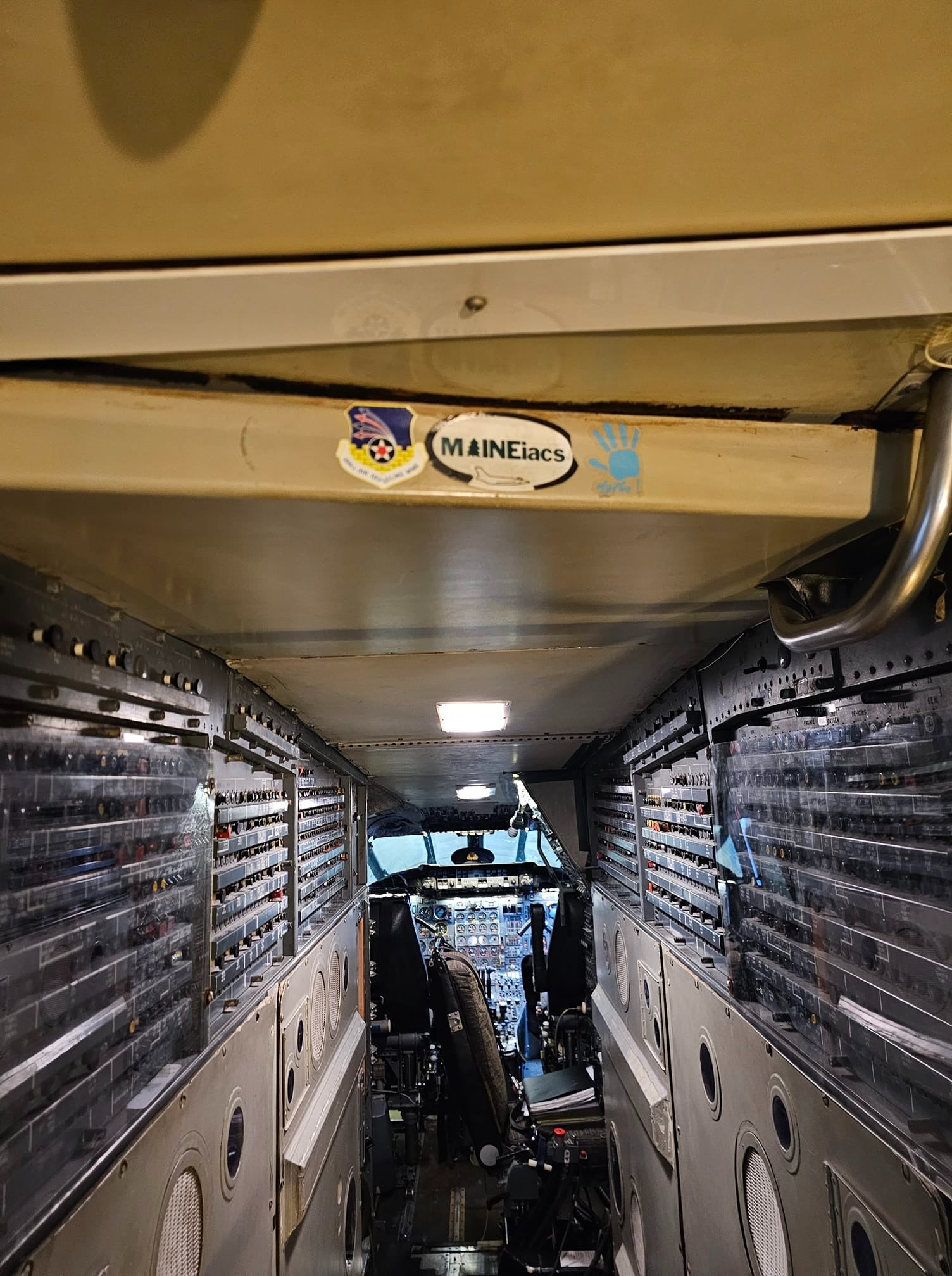
At least three left in the AFWATCH in the Pentagon that they haven't found yet lol.
It's like they issue members a stack of 100 each UTA. I was walking down a road in Cochem, Germany and there on the back of a road sign was one of those stickers.
What carnival ship was it? Cannot confirm or deny we may have involvement to the placement of stickers.
MacDill jet in Bangor, it was broke hard. So, it became an honorary MAINEiacs plane. August 2019.

There’s one here in a Bar and Grill off base, on the draft beer side panel.
They put a massive one (maybe 10’ long), over their dorm entrance at the Deid a couple years ago. The General said, “I’d tell em to take it down but they would just put another one up next week”
Bathroom urinal St Peter's basilica at Vatican.
Barrio Brewing in Tucson. Back corner of the bar, wasn’t expecting to see a piece of Bangor there.
A very small drinking establishment in soho London and in a hut selling beer on the top of Mt. Fuji
In AMS, the Chief came out and yelled at all of us, “And if I find one damned Maineiacs sticker on my base, you will all suffer!” At least a dozen appeared in creative places during that class alone.
In a bar and grill here in OKC.
Have seen them from Alpena Michigan to Djibouti and everywhere in between
I saw one in Germany. In the turret of an M-1 (A-Nothing) Abrams. Back when almost everything in and on that tank was classified. They do it by osmosis.
There are a few at the AFB I’m at in Mass, and saw a bunch at a deployed location in Saudi
I found one of these stickers on the underside of a toilet seat in Korea, I was equally impressed and grossed out.

Saw one in a flight line bus in Kansas.....up on forward bulkhead where it said "no stickers"
I saw one in the British Royal Engineers museum inside a Range Rover on a diorama.
I see Maineacs zaps in the most random places. Saw one in the Swizzle Inn in Bermuda recently.
I saw one on the inside of a gondola at Sugar Bowl ski area in NorCal.
They even zapped a burned out, rusted tank from WWII in Guam
Yo for real. Like literally everywhere I have traveled all over the world. Lol
I remember these stickers all over Al Udeid
The Maine ANG is by far the best at spreading their stickers around.. From every corner of the U.S., to Germany Guam, Japan and even on a tug in W. Africa (came from Italy/Germany), those guys put that sticker on everything. It’s impressive as hell. I always try to bring NH ones with me to put next to them.. haha
Got the inside of our toilet. Very dedicated
When I was at Andersen AFB, Guam these clowns somehow zapped the roof of our smoke pit. That lived rent free in my head, every day, for a good 4 years! Like 20 feet up on the roof ridge! I sometimes still try to wrap my head around how they got up there? The concrete picnic tables are the highest point you could climb up to, they were only like 3.5ft off the ground, and the end of the closest table was about 6ft from the wall.. at least.
Exploring the Legacy of the 101st Aerial Refueling Wing and the "Maineiacs" Stickers
In the realm of military aviation, symbols and insignias hold a significant place, often embodying the spirit, pride, and camaraderie of the units they represent. Among these symbols, the "Maineiacs" stickers of the 101st Aerial Refueling Wing of the Maine Air National Guard stand out as a unique and cherished tradition. These stickers, emblazoned with the word "Maineiacs" and an evergreen tree and stylized aircraft, have become synonymous with the unit's identity and its global footprint. To understand the significance of these stickers, we must delve into the rich history and operational excellence of the 101st ARW.
Origins and Heritage
The 101st Aerial Refueling Wing traces its lineage back to World War II, when it was established as the 406th Fighter Group on December 8, 1943. Originally formed to provide tactical air support in Europe, the unit distinguished itself in numerous campaigns, including the D-Day invasion and the Battle of the Bulge. After the war, the 406th Fighter Group was re-designated as the 101st Fighter Group and later transitioned to the role of an air defense unit.
In 1962, the unit underwent another transformation, becoming the 101st Air Refueling Wing. This change marked the beginning of its aerial refueling mission, a critical role that involved extending the operational range of military aircraft by refueling them mid-flight. Over the years, the 101st ARW honed its capabilities, earning accolades for its professionalism and effectiveness in supporting both domestic and international missions.
Mission and Capabilities
As part of the Maine Air National Guard, the 101st ARW operates out of Bangor Air National Guard Base, located at Bangor International Airport. Its primary mission is aerial refueling, accomplished using the versatile KC-135 Stratotanker aircraft. These massive tankers serve as the lifeline for countless military operations, enabling fighter jets, bombers, and other aircraft to reach distant locations without the need for frequent refueling stops.
The 101st ARW's contributions extend far beyond its home base in Maine. Through its participation in various operations and exercises, the unit plays a vital role in global power projection and deterrence. Whether supporting combat operations, conducting humanitarian missions, or providing aerial refueling for training exercises, the 101st ARW exemplifies the Air National Guard's commitment to service and readiness.
The Spirit of the Maineiacs
At the heart of the 101st ARW's identity lies the spirit of the "Maineiacs." This term, a playful nod to the unit's Maine roots, embodies the resilience, determination, and camaraderie of its members. The "Maineiacs" stickers, featuring an evergreen tree and an aircraft, serve as a tangible symbol of this spirit, adorning everything from aircraft to equipment and even personal belongings.
The tradition of the "Maineiacs" stickers dates back several decades, originating as a lighthearted way for unit members to personalize their gear and express pride in their unit affiliation. Over time, these stickers gained widespread popularity within the military community and beyond, becoming a familiar sight in air bases, deployments, and training exercises around the world.
Global Presence, Local Pride
One of the most remarkable aspects of the "Maineiacs" stickers is their ubiquitous presence across the globe. From remote airfields in the Middle East to bustling military installations in Europe and Asia, these stickers serve as a silent testament to the reach and influence of the 101st ARW. Wherever they go, unit members proudly display their "Maineiacs" stickers, forging connections and fostering camaraderie with fellow service members from different backgrounds and units.
For those serving far from home, the sight of a "Maineiacs" sticker can evoke feelings of nostalgia and belonging, reminding them of their roots in the Pine Tree State. Even in the midst of challenging deployments or austere environments, these stickers serve as a source of comfort and solidarity, uniting service members under a common banner of pride and heritage.
Commemorating Service and Sacrifice
Beyond their symbolic value, the "Maineiacs" stickers also carry a deeper significance as tokens of remembrance and honor. For the men and women of the 101st ARW, each sticker represents not only their own service but also the sacrifices of those who came before them. Whether paying tribute to fallen comrades or commemorating historic missions, these stickers serve as poignant reminders of the unit's legacy and the bonds that endure across generations.
In addition to their role in honoring the past, the "Maineiacs" stickers also inspire future generations of service members, instilling a sense of pride and tradition in those who carry on the unit's legacy. As new recruits join the ranks of the 101st ARW, they receive their own "Maineiacs" stickers, symbolizing their induction into a proud lineage of service and excellence.
Conclusion
In the annals of military history, symbols and insignias often serve as enduring reminders of the values and traditions that define a unit. For the 101st Aerial Refueling Wing of the Maine Air National Guard, the "Maineiacs" stickers represent more than just a whimsical emblem—they embody the spirit of pride, camaraderie, and service that has sustained the unit through decades of operations and deployments. As these stickers continue to adorn aircraft and equipment around the world, they serve as a testament to the enduring legacy of the 101st ARW and the indomitable spirit of the "Maineiacs" who proudly bear its name.
About Challenge Coin Nation
We at Challenge Coin Nation are a veteran founded company and are honored to be able to continue serving our brothers and sisters in arms all over the world. We sell many different military themed items, but challenge coins are our specialty. Check out some of our items below. Oh, and you might ask, “How much is shipping?” That’s an easy question. Shipping is free – worldwide!
Shop for stickers and zaps at these pages:
Challenge Coin Nation Stickers
de
The Maine Air National Guard (MEANG) has a rich and storied history that reflects both the evolution of military aviation in the United States and the unique character of the state of Maine. Since its inception, the MEANG has played a crucial role in the defense of the United States, contributing to both domestic security and international operations. This comprehensive overview will delve into the origins, development, and significant milestones of the MEANG, shedding light on the proud tradition of service and sacrifice that defines this venerable institution.
Origins and Formation
The roots of the Maine Air National Guard can be traced back to the early 20th century, during a time when the role of military aviation was rapidly expanding. The National Defense Act of 1916, which established the National Guard's aviation component, laid the groundwork for the eventual creation of the Air National Guard. However, it wasn’t until the aftermath of World War II that the modern Air National Guard, including the Maine Air National Guard, took shape.
In 1947, the United States Air Force was established as a separate branch of the military, independent of the Army. This reorganization led to the formation of the Air National Guard, intended to provide states with a ready reserve of trained airmen and aircraft. The Maine Air National Guard was officially founded on February 4, 1947, with the establishment of the 132nd Fighter Squadron. This unit, based at Dow Air Force Base in Bangor, Maine, was equipped with P-47 Thunderbolt aircraft, marking the beginning of the state's organized military aviation efforts.
Early Years: Post-World War II to the Korean War
The post-World War II era was a period of transition and growth for the Maine Air National Guard. The 132nd Fighter Squadron, initially equipped with propeller-driven P-47 Thunderbolts, soon transitioned to the more advanced F-51 Mustang, a testament to the rapid pace of technological advancement in military aviation. The squadron’s primary mission during this time was air defense, reflecting the broader strategic concerns of the early Cold War period.
In 1950, the outbreak of the Korean War tested the readiness and capabilities of the newly formed Air National Guard units across the country, including those in Maine. The 132nd Fighter Squadron was federalized and called to active duty, where it was assigned to the Strategic Air Command (SAC) and stationed at various bases across the United States. While the unit did not see combat in Korea, its activation underscored the importance of the Air National Guard in augmenting the regular Air Force during times of crisis.
The Korean War also prompted significant changes within the MEANG. The squadron's aircraft were once again upgraded, this time to the jet-powered F-80 Shooting Star, marking the transition from propeller-driven to jet-powered fighters. This change symbolized the broader shift within the U.S. military towards embracing the jet age, a move that would define the next several decades of military aviation.
The Cold War Era: Air Defense and Strategic Missions
The Cold War period was marked by a constant state of readiness, with the threat of nuclear conflict looming large over the United States and its allies. During this time, the Maine Air National Guard played a crucial role in the nation's air defense strategy, particularly in the protection of the northeastern United States from potential Soviet bomber attacks.
In 1954, the 132nd Fighter Squadron was redesignated as the 132nd Fighter-Interceptor Squadron, reflecting its new mission focus. The squadron was equipped with F-86 Sabre jets, which were later replaced by the more advanced F-101 Voodoo. These aircraft were tasked with intercepting and, if necessary, destroying enemy bombers that might attempt to penetrate U.S. airspace. The strategic location of Maine, with its proximity to the North Atlantic and the polar route used by Soviet bombers, made the MEANG a critical component of the nation’s air defense network.
The MEANG's mission during the Cold War was not limited to air defense. In 1968, the 101st Air Refueling Wing was established at Bangor International Airport, a former Strategic Air Command base. This unit was equipped with KC-135 Stratotankers, aircraft designed for mid-air refueling of bombers, fighters, and other military aircraft. The 101st Air Refueling Wing played a vital role in extending the reach of U.S. military forces, enabling them to operate globally without the need for frequent landings to refuel. This capability was particularly important during the Cold War, when the ability to project power and maintain a constant state of readiness was paramount.
The 101st Air Refueling Wing’s contributions were not limited to strategic deterrence. During the Vietnam War, MEANG personnel and aircraft were called upon to support operations in Southeast Asia. The wing's KC-135s were deployed to refuel combat aircraft over the skies of Vietnam, providing critical support to U.S. and allied forces engaged in combat operations. This deployment marked the first time that MEANG units were directly involved in a major conflict, setting the stage for future overseas deployments.
Post-Cold War Transformation and Modernization
The end of the Cold War in the early 1990s brought significant changes to the structure and mission of the U.S. military, including the Air National Guard. With the dissolution of the Soviet Union and the reduction of the nuclear threat, the focus of the MEANG shifted from air defense and strategic deterrence to a broader range of missions, including humanitarian assistance, disaster response, and support for overseas operations.
In 1991, the MEANG played a key role in Operation Desert Storm, the U.S.-led coalition’s response to Iraq’s invasion of Kuwait. The 101st Air Refueling Wing deployed its KC-135s to the Middle East, where they provided crucial refueling support to coalition aircraft conducting combat operations against Iraqi forces. The success of Operation Desert Storm highlighted the importance of air refueling in modern warfare and cemented the reputation of the MEANG as a reliable and capable force.
The 1990s also saw the MEANG undertake several humanitarian missions, both domestically and internationally. In 1992, the 101st Air Refueling Wing participated in Operation Provide Promise, a humanitarian relief operation in the former Yugoslavia. MEANG aircraft transported supplies and provided logistical support to the beleaguered civilian population affected by the conflict. This operation demonstrated the versatility of the MEANG and its ability to adapt to a wide range of mission requirements.
The turn of the century brought further modernization and transformation to the MEANG. In 2004, the 132nd Fighter Squadron transitioned to the F-15 Eagle, one of the most advanced fighter aircraft in the world. This upgrade significantly enhanced the squadron's air-to-air combat capabilities, ensuring that the MEANG remained at the forefront of the nation’s air defense efforts. The F-15’s superior speed, maneuverability, and weapons systems made it an ideal platform for the interception and destruction of enemy aircraft, further solidifying the MEANG’s role in protecting the skies over the northeastern United States.
The Global War on Terror: A New Era of Engagement
The terrorist attacks of September 11, 2001, marked a turning point in the history of the Maine Air National Guard. In the immediate aftermath of the attacks, MEANG units were mobilized to provide air defense over the northeastern United States as part of Operation Noble Eagle. The 132nd Fighter Squadron, equipped with F-15 Eagles, was tasked with intercepting any potential threats to the nation’s airspace, a mission that underscored the ongoing importance of air sovereignty in the post-9/11 world.
As the United States launched the Global War on Terror, the MEANG once again found itself at the forefront of military operations. The 101st Air Refueling Wing played a critical role in Operation Enduring Freedom in Afghanistan and Operation Iraqi Freedom in Iraq, providing air refueling support to U.S. and coalition aircraft conducting combat missions. The wing’s KC-135s were deployed to various locations in the Middle East and Central Asia, where they operated alongside active-duty Air Force units in some of the most challenging environments.
The MEANG’s contributions to the Global War on Terror were not limited to air refueling. In 2003, members of the 243rd Engineering Installation Squadron (EIS), another unit within the MEANG, were deployed to Iraq to support the reconstruction and stabilization efforts in the country. The 243rd EIS played a crucial role in rebuilding the communications infrastructure, enabling U.S. and coalition forces to maintain secure and reliable communications in a war zone. This deployment highlighted the diverse capabilities of the MEANG and its ability to contribute to a wide range of military operations.
Domestic Operations and Disaster Response
In addition to its overseas missions, the Maine Air National Guard has a long history of supporting domestic operations, particularly in response to natural disasters and emergencies. The MEANG’s unique capabilities and expertise have made it an invaluable asset in times of crisis, both in Maine and across the United States.
One of the most notable examples of the MEANG’s domestic contributions occurred in the aftermath of Hurricane Katrina in 2005. The 101st Air Refueling Wing was activated to provide airlift and logistical support to the disaster response efforts in the Gulf Coast region. MEANG personnel and aircraft transported supplies, equipment, and personnel to the affected areas, helping to alleviate the suffering of those impacted by the hurricane. This mission demonstrated the MEANG’s ability to rapidly respond to emergencies and provide critical support in the face of disaster.
The MEANG has also been involved in numerous other domestic operations, including responses to wildfires, floods, and snowstorms. The state of Maine, with its rugged terrain and harsh winters, is no stranger to natural disasters, and the MEANG has often been called upon to assist in these situations. Whether it’s providing airlift for supplies, conducting search and rescue operations, or supporting state and local authorities, the MEANG has consistently demonstrated its commitment to serving the people of Maine.
Modernization and Future Challenges
As the Maine Air National Guard looks to the future, it continues to adapt and evolve to meet the challenges of an increasingly complex and unpredictable world. Modernization efforts are underway to ensure that the MEANG remains a capable and relevant force, capable of defending the United States and supporting its allies in a wide range of scenarios.
One of the key areas of focus for the MEANG in recent years has been the modernization of its aircraft and equipment. The 101st Air Refueling Wing, for example, has been working to upgrade its fleet of KC-135 Stratotankers, ensuring that these aircraft remain capable of meeting the demands of modern military operations. The wing has also been exploring the potential for future aircraft acquisitions, such as the KC-46 Pegasus, which would further enhance its refueling capabilities.
The 132nd Fighter Squadron, meanwhile, continues to operate the F-15 Eagle, an aircraft that, despite its age, remains one of the most capable air superiority fighters in the world. The squadron has been involved in various training exercises and deployments, ensuring that its pilots and support personnel are prepared for any contingency. The MEANG has also been exploring the possibility of transitioning to the F-35 Lightning II, the latest generation of stealth fighters, which would represent a significant leap forward in capabilities.
In addition to modernization, the MEANG is also focused on addressing the challenges posed by emerging threats, such as cyber warfare and space operations. The increasing reliance on digital networks and the growing importance of space in military operations have created new vulnerabilities that the MEANG must be prepared to address. To this end, the MEANG has been working to enhance its cyber capabilities, training personnel to defend against cyberattacks and ensure the integrity of its communications and command systems.
The MEANG is also looking to the future of space operations, recognizing the growing importance of space in modern warfare. While the U.S. Space Force is the primary branch responsible for space operations, the MEANG is exploring ways to contribute to this mission, potentially through partnerships and collaborations with other military and civilian organizations.
The Legacy of the Maine Air National Guard
The Maine Air National Guard’s history is one of service, sacrifice, and commitment to the defense of the United States and the state of Maine. From its humble beginnings as a single fighter squadron in 1947 to its current status as a highly capable and versatile force, the MEANG has consistently demonstrated its dedication to protecting the nation’s interests at home and abroad.
Throughout its history, the MEANG has been called upon to serve in some of the most challenging and dangerous environments, from the frozen skies of the Cold War to the deserts of the Middle East. Its personnel have displayed exceptional skill, bravery, and professionalism, earning the respect and admiration of their peers and the gratitude of the American people.
The MEANG’s legacy is also one of adaptability and innovation. Over the years, the MEANG has embraced new technologies and capabilities, ensuring that it remains at the forefront of military aviation. Whether it’s transitioning from propeller-driven aircraft to jet fighters, adopting new refueling techniques, or exploring the possibilities of cyber and space operations, the MEANG has consistently shown its ability to evolve and meet the demands of a changing world.
As the MEANG looks to the future, it does so with a deep sense of pride in its history and a strong commitment to its mission. The challenges of the 21st century are formidable, but the MEANG is well-prepared to face them, drawing on the experience and expertise gained over more than seven decades of service. The men and women of the Maine Air National Guard stand ready to continue their tradition of excellence, protecting the skies over the Pine Tree State and beyond for generations to come.
The history of the Maine Air National Guard is a testament to the enduring spirit of the people of Maine and their commitment to the defense of the United States. From its origins in the post-World War II era to its current role in the Global War on Terror and beyond, the MEANG has played a vital role in the nation’s military efforts, contributing to the safety and security of the American people. As the MEANG continues to evolve and adapt to the challenges of the future, it remains a symbol of the strength, resilience, and dedication that have defined the state of Maine for centuries.















Leave a comment